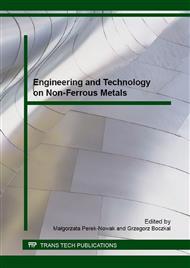[1]
M. Książek, I. Nejman, R. Grzelka, P. Pałka, The influence of thermal sprayed coats chemical composition on the microstructure and properties. Material Science Forum (2011) 113-120.
DOI: 10.4028/www.scientific.net/msf.674.113
Google Scholar
[2]
G. Barbezat, Advanced thermal spray technology and coating for lightweight engine blocks for the automotive industry. Surface and Coatings Technology 200 (200) 1990-(1993).
DOI: 10.1016/j.surfcoat.2005.08.017
Google Scholar
[3]
P. Fauchas, G. Montavon, M. Vardelle, J. Cedelle, Developments in direct current plasma spraying. Surface and Coatings Technology 201 (2006) 1908-(1921).
DOI: 10.1016/j.surfcoat.2006.04.033
Google Scholar
[4]
N. Espallargs, J. Berget, J. M. Guilemany, A. V. Benedetti, P. H. Suegama, Cr3C2 – NiCr and WC-Ni thermal spray coatings as alternatives to hard chromium for erosion – corrosion resistance. Surface and Coatings Technology 202 (2008) 1405-1417.
DOI: 10.1016/j.surfcoat.2007.06.048
Google Scholar
[5]
S. Matthews, B. James, M. Hyland, Erosion of oxide scale formed an Cr3C2 - NiCr thermal spray coatings. Corrosion Science 50 (2008) 3087- 3094.
DOI: 10.1016/j.corsci.2008.08.032
Google Scholar
[6]
C. A. da Cunha, N. B. de Lima, J. R. Martinelli, A. H. de Almeida Bressiani, A. G. F. Padial, L. V. Ramanatha,. Microstructure and mechanical properties of thermal Spray Nanostructured Cr3C2 - Ni20Cr Coatings. Materials Research 11 (2008).
DOI: 10.1590/s1516-14392008000200005
Google Scholar
[7]
J. He, M. Ice, J. M. Schoenung, D. H. Shin, E. J. Lavernia, Thermal Stability of Nanostructured Cr3C2 - NiCr Coatings. JTTEE 10 (2000) 293-300.
DOI: 10.1361/105996301770349385
Google Scholar
[8]
M. Richert, The wear resistance of thermal spray the tungsten and chromium carbides coatings, Journal of Achievements in Materials and Manufacturing Engineering. 47 (2011) 177-183.
Google Scholar
[9]
P. Fauchais, Understanding plasma spraying. Journal of Physics 37 (2004) 86-108.
Google Scholar
[10]
M. Richert, I. Nejman, M. Poręba, J. Sieniawski, Ł. Kuczek, Effect of plasma gases on the structure and properties of WC-CrC-Ni coatings, Key Engineering Materials 641 (2015) 105-110.
DOI: 10.4028/www.scientific.net/kem.641.105
Google Scholar
[11]
J. Mostaghimi, S. Chandra, Splat formation in plasma-spray coating process, Pure Appl. Chem. 74 (2004) 441 - 445.
DOI: 10.1351/pac200274030441
Google Scholar
[12]
O. Sarikaya, Effect of some parameters on microstructure and hardness of alumina coatings prepared by the air plasma spraying process. Surface and Coatings Technology 190 (2005) 388-393.
DOI: 10.1016/j.surfcoat.2004.02.007
Google Scholar
[13]
I. Nejman, M. Richert, S. Pietrzyk, P. Pałka, The analysis of mictrostructure and properties Al2O3, ZrO2-Y2O3 coats produced by thermal spraying method at graphite substrate. Rudy i Metale Nieżelazne.
Google Scholar
[14]
You Wang, Stephen Jiang, Meidong Wang, Shihe Wang, T. Danny Xiao, Peter R Strutt, Abrasive wear characteristics of plasma sprayed nanostructure alumina/titania coatings. Wear 237 (2000) 176-185 6 (2014) 273-278.
DOI: 10.1016/s0043-1648(99)00323-3
Google Scholar
[15]
M. Richert, M. Książek, B. Leszczyńska – Madej, I. Nejman, R. Grzelka, P. Pałka, The Cr3C2 thermal spray coating on Al-Si substrate, Journal of Achievements in Materials and Manufacturing Engineering. 38 (2010) 95-102.
Google Scholar
[16]
P. Sokołowski, L. Łatka, A. Ambroziak, The characterization of microstructure and selected properties of zirconia coatings obtained by suspension plasma spraying method. Overview of Welding (2014) 6, 48-54.
DOI: 10.26628/ps.v86i6.71
Google Scholar
[17]
Q. Yu, Ch. Zhou, H. Zhang, Thermal stability on nanostructured 13 wt% Al2O3 – 8wt% Y2O3 – ZrO2 thermal barrier coatings. Journal of the European ceramic Society 30 (2010) 889-897.
DOI: 10.1016/j.jeurceramsoc.2009.10.005
Google Scholar
[18]
S. Nath, I. Manna, J. Majumdar, Nanomechanical behaviour of yttria stabilized zirconia (YSZ) based thermal barrier coating. Ceramics International (2015) 41 5247-5256.
DOI: 10.1016/j.ceramint.2014.11.039
Google Scholar
[19]
J. Myalski, Aluminium matrix composite with low value of coefficient of friction. Composites 2 (2003) 4, 191-194.
Google Scholar
[20]
H. Tomaszewski, Viteous carbon - a new form of carbon for industrial applications. Electronicmaterials 21 (1978) 1, 27-39.
Google Scholar
[21]
J. Myalski, Influence of glass carbon addition on tribological properties of metal matrix composite materials. Composites 3 (2003) 8, 317-321.
Google Scholar
[22]
J. Myalski, J. Wieczorek, A. Dolata-Grosz, J. Śleziona, Tribological properties of heterophase composites with ceramic and amorphous carbon particles compositions. Composites 5 (2005) 2, 11-16.
Google Scholar


